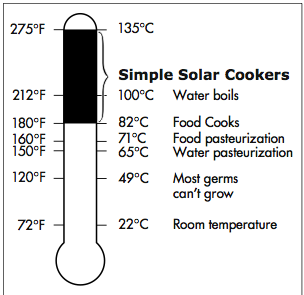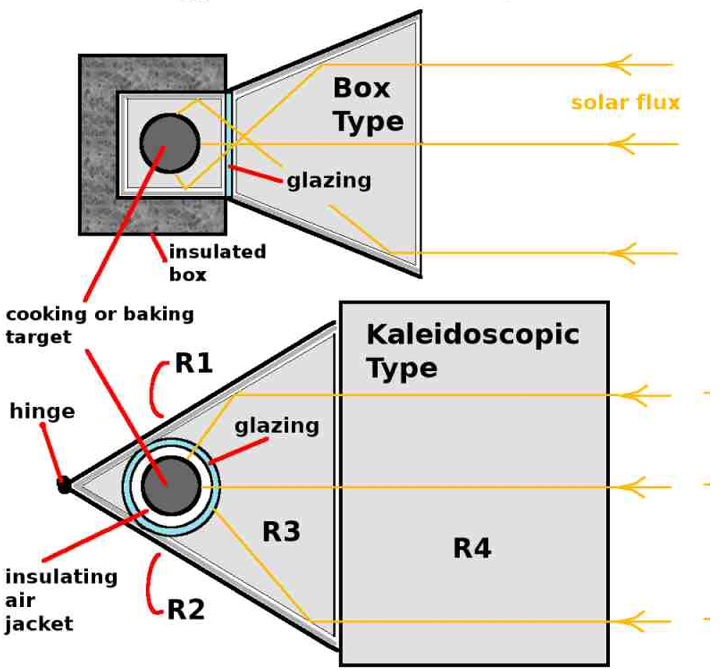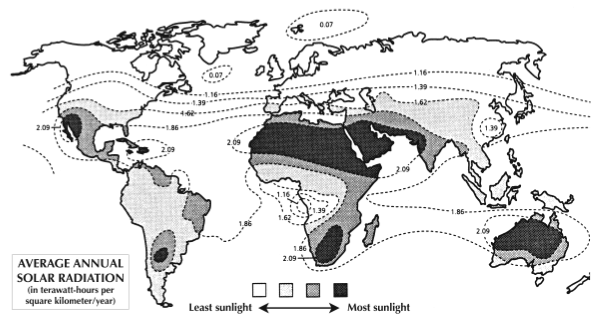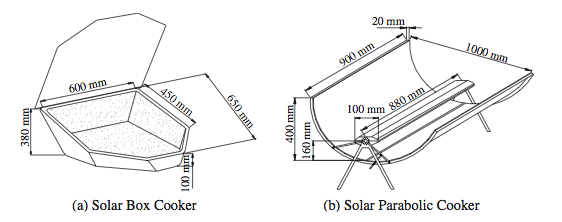({{Solar navbox}}) |
Tom Sponheim (talk | contribs) (improves section) |
||
| Line 227: | Line 227: | ||
Several Non-Government Organizations (NGO's) and private organizations have taken it upon themselves to promote the benefits of solar cooking in developing rural areas, from creating DIY designs to setting up training camps to educate villagers on how to build and cook with these devices. Some of these groups are listed below: | Several Non-Government Organizations (NGO's) and private organizations have taken it upon themselves to promote the benefits of solar cooking in developing rural areas, from creating DIY designs to setting up training camps to educate villagers on how to build and cook with these devices. Some of these groups are listed below: | ||
# Solar Cookers World Network, http://solarcooking.wikia.com | |||
# Solar Cookers International. http://www.solarcookers.org/ | # Solar Cookers International. http://www.solarcookers.org/ | ||
# Kyoto Twist Solar Cooking Society. http://www.kyototwist.org/ | # Kyoto Twist Solar Cooking Society. http://www.kyototwist.org/ | ||
# Gadhia Solar Energy Systems Pvt. Ltd. http://solarcooking.wikia.com/wiki/Gadhia_Solar_Energy_Systems | # Gadhia Solar Energy Systems Pvt. Ltd. http://solarcooking.wikia.com/wiki/Gadhia_Solar_Energy_Systems | ||
# Articles about more than 500 solar cooking NGOs, http://solarcooking.wikia.com/NGOs | |||
= References = | = References = | ||
Revision as of 18:50, 13 February 2013
Template:Statusboxtop Template:Status-Design You can help Appropedia by contributing to the next step in this OSAT's Category:Status Template:Boxbottom
Abstract
The primary goal of this AT project is to consolidate existing information on solar cooking, as well as evaluate materials and design techniques utilized for the construction of popular contemporary models.
Introduction
Cooking in developing countries is customarily done on open fires using firewood, charcoal, and kerosene. This leads to deforestation in these rural regions as well as causing excessive pollution and significant smoke inhalation.
Solar cookers work on the basic principle of sunlight being converted to thermal energy that is retained and used for outdoor cooking purposes, and have the most positive impact in sunny, fuel-scarce regions of the world. Solar cookers provide a space of hot air, which directly heats the pot and food.
Some alternate uses for solar cookers:
- Water pasteurization
- To disinfect dry medical supplies
- To sanitize utensils

Advantages
- In villages, women have to travel less often to forage for firewood, thus keeping them closer to home and safe as a result.
- Cheaper than cooking with firewood or charcoal
- Reduced CO2 emissions
- Solar cookers can be easily constructed in a matter of hours after very basic training
- Solar cookers are generally light-weight
Limitations
- It can take very long to cook a meal
- It is not always sunny
- Solar cooking can only be performed when the sun is strong enough during mid-day, however hot food may be required much earlier on in the day.
- Cooking has to be undertaken outside which may pose additional threats in developing countries
- Will not perform well in windy areas
- Can be inconsistent and may produce inedible food
Factors for comparing solar cookers
- Cost
- Convenience
- Safety
- Wind resistance
- Heating capacity
- Durability - repairs should be infrequent and easily performed
- Simplicity of instructions
Development of direct heat technology could significantly reduce the cost of solar cooking technologies.
Design of a solar cooker
How it works
Essentially, reflectors in the solar cooker focus sunlight on a dark pot within the solar cooker, which has a tight-fitting lid to contain heat and moisture. A dark pot is used as it absorbs the maximum amount of heat, and allows higher cooking temperatures.
In order to trap heat, isolating the air inside the cooker from the surrounding atmosphere makes an important difference. Using a clear solid, like a plastic bag or a glass cover, will allow light to enter, but once the light is absorbed and converted to heat, a plastic bag or glass cover will trap the heat inside. This allows temperature to reach similar levels on cold and windy days as on hot days. These plastic sheets have an added benefit of blocking any leakages that could potentially seep through and damage the cooker.
Cooking containers and the inside bottom of the cooker should be dark-colored or black. Inside walls should be reflective to reduce radiative heat loss and bounce the light towards the pots and the dark bottom, which is in contact with the dark pots. [2]
A solar cooker can be advisably used when the length of one's shadow on the ground is shorter than that individual's height. This indicates that the sun is high enough in the sky to allow for efficient cooking.

Efficiency analysis of a solar cooker
Energy efficiency
Based on the 1st Law of Thermodynamics: [4]
Energy input = Energy output + Energy losses
Energy input to the solar cooker can be calculated as follows:
Where:
Ei is the energy input in W
It = total solar energy incident upon plane of the solar air being heated in W/m2
Asc is the surface area of the solar cooker
Energy output from the solar cooker can be found as shown below:
Where:
Eo is the energy output in W
mw is the mass of water in kg
cpw = specific heat of water in J/kgK
Asc is the surface area of the solar cooker
Twi is the initial temperature of the water in K
Twf is the final temperature of the water in K
t is the time in seconds
Energy efficiency of the solar cooker can be found as shown below:
Exergy efficiency
Based on the 2nd Law of Thermodynamics: [5]
Exergy input = Exergy output + Irreversibility
Exergy input to the solar cooker can be calculated as follows:
Where:
Exergy input in W/m2
Ib = the radiation of the sunbeam in W/m2
To is the outside temperature in K
Ts is the surface temperature of the sun in K
Exergy efficiency of the solar cooker can be calculated as follows:

Where:
Asc is the intercept area of the solar cooker
Regional Considerations
Approximately 600,000 cookers are being used in the Andes, Tibet, Nepal, Mongolia and parts of China. However, the biggest recent success story has been in villages in India. [6]
If most of the following conditions apply, this region may be suitable for solar cooking:
Mostly-sunny days throughout several months of the year.
Outdoor space available that remains sunlit for several hours and sheltered from high winds.
If local cooking fuels are expensive or difficult to obtain.
Can be alternatively used in situations where safe drinking water is unavailable.
Due to the abundance of sunlight, several areas in Asia, Africa, and Australia can greatly benefit from the use of solar cookers as shown in Figure 3 below:

Required Materials
A sturdy solar oven can be built from cheap and common materials in a matter of a few hours.
Materials:
Cardboard boxes (or bamboo), aluminum foil, black paint, plastic sheets
Panel and box cookers are easily and inexpensively built using corrugated cardboard (carton board) as the form. To increase durability, outer, non-reflective surfaces can be painted, oiled or waxed to help protect from moisture.
• Plain or corrugated plastics
• Wood
• Woven mats
OUTER BOX : Should be made of materials that are well insulated and can be sealed well with the lid. Several of the following materials will satisfy these requirements:
• Plain or corrugated plastics
• Wood
• Metal
• Masonite
• Bricks
INNER BOX: Should be able to withstand high temperatures without releasing any fumes. The surface that faces the cooking pot should be reflective, lined with reflective material, or black. Several of the following materials will satisfy these requirements:
• Wood
• Sheet metal
• Masonite
• Woven baskets
• Mats
GLUE: Avoid using tape petroleum- and rubber-based glues for inner cooking surfaces. Advisable glues include:
• Water-based polyvinyl acetate glues (preferably evenly diluted with water)
• Wheat or rice flower paste
• Acacia gum
• Casein glue
Required Tools
Required Skills and Knowledge
Construction of a solar cooker

Financial Analysis
Approximately 2,400 square centimeters of scrap aluminum plate will make one 20 cm x 27.5 cm x 5.5 cm pan, with cover. The material cost is less than $0.30 per pan. [9]
This can be used as a reference to construct your own solar cooker with the aluminum plates available locally. The size of the cooker will be dependent on the size of the pan, and the overall unit size is subject to what is most economical in your particular geographic region.
Related Organizations
Several Non-Government Organizations (NGO's) and private organizations have taken it upon themselves to promote the benefits of solar cooking in developing rural areas, from creating DIY designs to setting up training camps to educate villagers on how to build and cook with these devices. Some of these groups are listed below:
- Solar Cookers World Network, http://solarcooking.wikia.com
- Solar Cookers International. http://www.solarcookers.org/
- Kyoto Twist Solar Cooking Society. http://www.kyototwist.org/
- Gadhia Solar Energy Systems Pvt. Ltd. http://solarcooking.wikia.com/wiki/Gadhia_Solar_Energy_Systems
- Articles about more than 500 solar cooking NGOs, http://solarcooking.wikia.com/NGOs
References
- ↑ Solar Cookers International, "How to make a solar cooker", http://images3.wikia.nocookie.net/__cb20090108164302/solarcooking/images/5/57/CooKit_plans_detailed.pdf, Accessed April 6, 2010
- ↑ Wikipedia, "Solar cooker", http://en.wikipedia.org/wiki/Solar_cooker, Accessed April 3, 2010
- ↑ CurlyDock, "Two Types of Solar Cookers/Bakers", hhttp://curlydock.files.wordpress.com/2007/09/lores-diagram-of-types.jpg, Accessed April 8, 2010
- ↑ Ozturk, H. "Second Law Analysis for Solar Cookers", http://www.informaworld.com/smpp/1138067100-85020668/content~db=all~content=a713635696, Accessed April 8, 2010
- ↑ Ozturk, H. "Second Law Analysis for Solar Cookers", http://www.informaworld.com/smpp/1138067100-85020668/content~db=all~content=a713635696, Accessed April 8, 2010
- ↑ Deutsche Welle, "Cooking with the power of the sun", http://www.dw-world.de/dw/article/0,,5205895,00.html, Accessed April 3, 2010
- ↑ Solar Cookers International, "How to make a solar cooker", http://images3.wikia.nocookie.net/__cb20090108164302/solarcooking/images/5/57/CooKit_plans_detailed.pdf, Accessed April 6, 2010
- ↑ Ozturk, H. "Second Law Analysis for Solar Cookers", http://www.informaworld.com/smpp/1138067100-85020668/content~db=all~content=a713635696, Accessed April 8, 2010
- ↑ The Solar Cooking Archive, "SunPan Overview", http://www.sungravity.com/sunpan_overview.html, Accessed April 4, 2010